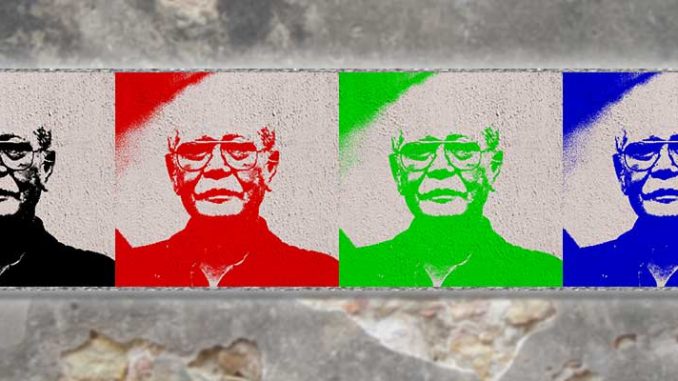
By the middle of 1961 Minangkabau patriotism was ruined. The PRRI “Revolutionary Government” secessionists, whose three year struggle against the national state had been a protest against the central government’s perceived Javanism and communism, were beaten. Minangkabau people left West Sumatra for Jakarta and Medan, never to return. This was a time of rantau cino, permanent “Chinese” out-migration, when Minangkabau gave their children Javanese names and grumbled that at home in Sumatra “the winners (yang Minang) have all left, what remains are the water buffalo (Ka[r]bau).” Jakarta’s Padang restaurants boomed and migrants from Sumatra, ethnicity withheld, fitted themselves into lives far from ancestral highlands and unhappy memories.
1963 brought another slap to the exhausted Minangkabauists. In his wonderfully bizarre “Tuanku Rao: Hambali Islamic Terror in the Batak Lands (1816-1833),” the Mandailing writer Mangaradja Onggang Parlindungan scoffed,
“Brothers from Minang sangat parah handicapped, karena kepertjajaan mereka akan mythos2 tanpa angka2 tahunan. Mythos Iskandar Zulkarnain Dynasty, Mythos Menang Kerbau, Mythos Bundo Kanduang, Tambo Minangkabau, dlsb., semuanya 100% ditelan oleh Brothers from Minang. Tanpa mereka sanggup selecting-out 2% facta2 sejarah dan kicking-out 98% mythologic ornamentations dari mythos2 itu. Tanpa mereka sedikit pun usaha, mentjarikan angka2 tahunan untuk menghentikan big confusions” (679).
[The Brothers from Minang are severely handicapped due to their belief in ahistorical myths. The myth of Alexander the Great’s dynasty, the myth of the Victorious Buffalo, the myth of the Ur-Mother, the Legend of Minangkabau and the like have been swallowed whole by the Brothers from Minang. They have been incapable of selecting-out the 2% historical facts and kicking-out the 98% mythologic ornamentations within those myths. They have not made the slightest effort to seek out accurate dates and put an end to the big confusions.]It took the fall of Sukarno and the destruction of the Indonesian Communist Party for the brothers from Minangkabau to answer Parlindungan’s challenge. The first “History of Minangkabau” was published in 1970 and included a self-congratulatory foreword by Parlindungan himself. With accurate dates and a substantial bibliography, the authors synthesized the ethno-mythical history of Minangkabau and the political history of West Sumatra. The great Islamic populist intellectual, Hamka, directly challenged Parlindungan in his 1974 book “‘Tuanku Rao’ Between Fact and Fantasy.” But the most concerted effort to rewrite the history of Minangkabau was undertaken by Rusli Amran, a retired officer of the Indonesian Foreign Service.
Rusli Amran was born in Padang in 1922 and educated in the Dutch, Japanese, and national school systems. During the Revolution he helped found the newspaper Berita Indonesia and in the early 1950s joined the state bureaucracy, first the Ministry of Defense, then Economy, and finally Foreign Affairs. He represented the Republic of Indonesia in Moscow and Paris through the decade when Minangkabau was most alienated from the nationalist project. When Amran retired in 1972 he devoted himself to a massive historical project: the writing of West Sumatran history in a form both comprehensive and accessible to Indonesian students.
Rusli Amran loved the archive. He spent much of the 1970s and 1980s mining the resources in the Netherlands and Jakarta, paying particular attention to research and reports available in nineteenth century Dutch colonial journals. His first of five books, “West Sumatra up to the Plakat Panjang,” is a massive history that includes archaeological sources from the thirteenth century, but is most concerned with the interactions of British, Dutch, and Minangkabau up through the Padri Wars and the “long declaration” (Plakat Panjang) that marked the beginning of intensive Dutch administration in West Sumatra. Amran’s research is rigorous but his style is informal. He is careful to translate all quotations and sources into Indonesian, and titles a chapter on initial European penetration “Masuklah Si Bule,” Enter Whitey. This first book is his most ambitious – almost 700 pages long, with a thorough bibliography and legible facsimile reproductions of archival documents and original source materials. His second book, “West Sumatra Plakat Panjang,” is a continuation of the first and along with translations of Dutch sources contains appendices of data culled from Dutch journals. Both these books make linguistically and logistically difficult Dutch sources easily accessible to Indonesian students of West Sumatran history.
Amran’s third book in the series, “West Sumatra: The Anti-Tax Rebellion of 1908,” closes his history of the coffee cultivation system and nineteenth century colonial exploitation with a study of reactions to the imposition of a money tax. His fourth book is a break with the narrative – a quirky tribute to his hometown of Padang that mixes archival and anecdotal sources to focus on personal histories and studies of the Eurasian community and the role of the Javanese. He also includes an impressive collection of reproduced photographs. This work in many ways anticipates much of the current scholarship on race and social change in the colonial period. Amran’s insistence on using the name “West Sumatra” rather than the ethnically-defined “Minangkabau” in all of his writings reinforces his important interpretation of West Sumatra as a multi-ethnic society and its history as one of interactions among Europeans, Chinese, Javanese, Batak, and Minangkabau. Amran’s final book, published after his death in 1996, is a collection of essays entitled “Old Tales from the Pages of History.” These essays are wonderful explorations into some of the stranger figures and moments in West Sumatran history and make for light and stimulating reading.
As important as Rusli Amran’s writings is another extraordinary act of generosity. While undertaking archival research, he photocopied every available journal article and manuscript relating to West Sumatra. This is an enormous collection of documents. Amran then made multiple copies of this collection and deposited them in three locations in West Sumatra: the library of the Literature and Humanities Division of Andalas University in Limau Manis; the reading room of the West Sumatran Arts Council in the Abdullah Kamil Building in Padang; and the Center for Documentation and “Inventorization” of Minangkabau Culture in Padang Panjang. Through Amran’s efforts students of West Sumatran history have access to books that provide lucid and unpretentious introductions to the colonial period. And they also have access to the primary sources without having to travel to the Netherlands or even Jakarta. Finally, Rusli Amran’s widow has established the Yayasan Rusli Amran in Jakarta to house a study and documentation center and to support research into West Sumatran history. While largely unknown internationally, Rusli Amran has done much to foster the study of Minangkabau history in Indonesia. His books are well worth reading.
Jeffrey Hadler
The author is assistant professor in the Department of South and Southeast Asian Studies, University of California, Berkeley.
Kyoto Review of Southeast Asia. Issue 3: Nations and Other Stories. March 2003
References
Parlindungan, Mangaradja Onggang. 1963. Pongkinangolngolan Sinambela gelar Tuanku Rao: Terror Agama Islam Mazhab Hambali di Tanah Batak 1816-1833. Jakarta: Penerbit Tandjung Pengharapan.
Mansoer, M.D. et al. 1970. Sejarah Minangkabau. Jakarta: Bhratara.
Hamka. 1974. Antara Fakta dan Khayal “Tuanku Rao.” Jakarta: Bulan Bintang.
Amran, Rusli. 1997. Cerita-Cerita Lama Dalam Lembaran Sejarah. Jakarta: Balai Pustaka.
Amran, Rusli. 1988. Sumatra Barat Pemberontakan Pajak 1908: Bag. Ke-1, Perang Kemang. Jakarta: Gita Karya.
Amran, Rusli. 1988. Padang Riwayatmu Dulu. Revised edition. Jakarta: C.V. Yasaguna.
Amran, Rusli. 1985. Sumatra Barat Plakat Panjang. Jakarta: Sinar Harapan.
Amran, Rusli. 1981. Sumatra Barat Hingga Plakat Panjang. Jakarta: Sinar Harapan.

